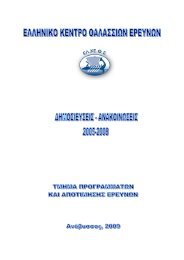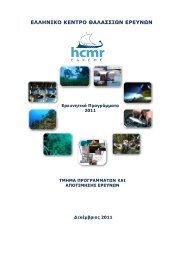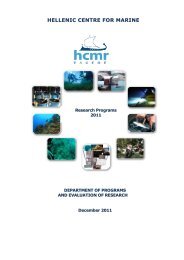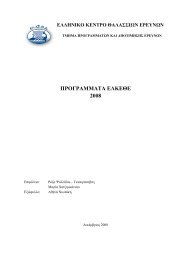2009 Research Programmes of the HCMR - Hellenic Centre for ...
2009 Research Programmes of the HCMR - Hellenic Centre for ...
2009 Research Programmes of the HCMR - Hellenic Centre for ...
You also want an ePaper? Increase the reach of your titles
YUMPU automatically turns print PDFs into web optimized ePapers that Google loves.
Scientific team (ΗCMR): Dr A. Karageorgis<br />
Brief Description <strong>of</strong> <strong>the</strong> Program: This project belongs to <strong>the</strong> category <strong>of</strong> Marie Curie<br />
Reintegration Grants (IRG) <strong>of</strong> FP7, <strong>the</strong> goal <strong>of</strong> which is to support <strong>the</strong> repatriation <strong>of</strong> a young<br />
scientist, who will have <strong>the</strong> opportunity to work at <strong>the</strong> <strong>HCMR</strong>. Dr. Efthymios Tripsanas, who just<br />
recently returned from <strong>the</strong> USA, will work under <strong>the</strong> supervision <strong>of</strong> Dr. Aristomenis Karageorgis in<br />
<strong>the</strong> integrated palaeontological – sedimentological study <strong>of</strong> a large set <strong>of</strong> sediment cores, ultrahigh-<br />
and high-resolution seismic-reflection pr<strong>of</strong>iles from <strong>the</strong> Cretan Sea, South Aegean Sea.<br />
Changes in <strong>the</strong> ocean circulation and climate have been brought to <strong>the</strong> focus <strong>of</strong> research mainly<br />
during <strong>the</strong> last thirty years, due to <strong>the</strong>ir correlation to human activities. A dramatic hydrological<br />
change occurred during <strong>the</strong> last twenty years in <strong>the</strong> Eastern Mediterranean, where <strong>the</strong>re has been a<br />
switch in <strong>the</strong> <strong>for</strong>mation <strong>of</strong> new deep water from <strong>the</strong> Adriatic Sea to <strong>the</strong> Aegean Sea. This is<br />
attributed to <strong>the</strong> increased salinity <strong>of</strong> <strong>the</strong> surface waters <strong>of</strong> <strong>the</strong> Mediterranean Sea due to river<br />
damming and decreased precipitation. The impact <strong>of</strong> this phenomenon in <strong>the</strong> hydrology and<br />
ecological system <strong>of</strong> <strong>the</strong> Eastern Mediterranean has puzzled <strong>the</strong> scientific community. The<br />
limitation <strong>of</strong> detailed hydrological data <strong>for</strong> <strong>the</strong> past 50 years does not allow numerical simulations<br />
to make any accurate long-term predictions, whereas conventional paleoceanographic studies fail to<br />
capture similar short-lived events <strong>of</strong> <strong>the</strong> past due to <strong>the</strong>ir low time resolution (~0.2-0.5 ky).<br />
The integrated paleoceanographic-sedimentological study <strong>of</strong> a large set <strong>of</strong> sediment cores and ultrahigh-resolution<br />
seismic-reflection pr<strong>of</strong>iles from <strong>the</strong> Cretan Basin, Aegean Sea, is proposed.<br />
Petrographic, geochemical, paleontological, and δ18O isotope analysis in selected stratigraphic<br />
cores will result in <strong>the</strong> development <strong>of</strong>: 1) a preliminary paleoceanographic record, and 2) a<br />
detailed sediment/seismic stratigraphic scheme. Accurately dated sedimentary units in both, cores<br />
and seismic-reflection pr<strong>of</strong>iles will <strong>the</strong>n be identified and mapped, and <strong>the</strong> response <strong>of</strong><br />
sedimentological processes to climatic-hydrological changes will be determined. The depositional<br />
time <strong>of</strong> some sedimentary beds (e.g. turbidites and bottom-current deposits) ranges from hours to<br />
years. Thus, a reverse correlation <strong>of</strong> <strong>the</strong> identified sedimentary units to climatic-hydrological<br />
changes will lead to <strong>the</strong> <strong>for</strong>mation <strong>of</strong> an ultra-high-resolution (tens <strong>of</strong> years) paleoceanographic<br />
record <strong>for</strong> <strong>the</strong> Cretan Sea, and by extrapolation <strong>for</strong> <strong>the</strong> entire Eastern Mediterranean Sea.<br />
POSEIDON-III: A monitoring and <strong>for</strong>ecasting system <strong>for</strong> <strong>the</strong> Eastern Mediterranean Sea<br />
with emphasis on climate change and protection <strong>of</strong> <strong>the</strong> marine ecosystem (ΠΟΣΕΙ∆ΩΝ ΙΙΙ/<br />
776).<br />
Scientific Coordinator:<br />
Dr K.Nittis<br />
Funding: EEA/EFTA (50%) – Ministry <strong>of</strong> Economy & Finance (50%)<br />
Starting Year: <strong>2009</strong><br />
Duration: 30 months (17/04/09-16/10/11)<br />
Total Budget: 1.059.600<br />
Study Area:<br />
SE Ionian Sea<br />
Scientific team (ΗCMR): Dr Κ.Νittis, Dr V. Likousis, Dr G. Korres, Dr G. Petihakis, D. Ballas, P.<br />
Pagonis, L. Perivoliotis, D. Kassis, P. Kousoulidis, A. Diapouli<br />
Brief Description <strong>of</strong> <strong>the</strong> Program: The overall goal <strong>of</strong> <strong>the</strong> project is <strong>the</strong> operational monitoring<br />
and study <strong>of</strong> physical and biochemical deep sea processes through <strong>the</strong> development <strong>of</strong> a deep<br />
seafloor observatory in <strong>the</strong> SE Ionian Sea (Poseidon-Pylos station) and its integration with <strong>the</strong> E1-<br />
M3A observatory <strong>of</strong> <strong>the</strong> Cretan Sea. The seafloor observatory will have <strong>the</strong> capability to operate in<br />
depths greater than 2000m and to host a large number <strong>of</strong> sensors. Through hydroacoustic modems<br />
it will be able to communicate with similar peripheral seafloor systems, thus having <strong>the</strong> capability<br />
to generate a network <strong>of</strong> plat<strong>for</strong>ms in <strong>the</strong> future. Fur<strong>the</strong>rmore, <strong>the</strong> project will upgrade with new<br />
sensors <strong>the</strong> water column component <strong>of</strong> <strong>the</strong> Poseidon-Pylos observatory that will thus become<br />
compatible and interoperable with <strong>the</strong> respective system in <strong>the</strong> Cretan Sea in terms <strong>of</strong> biochemical<br />
observations.<br />
3
















